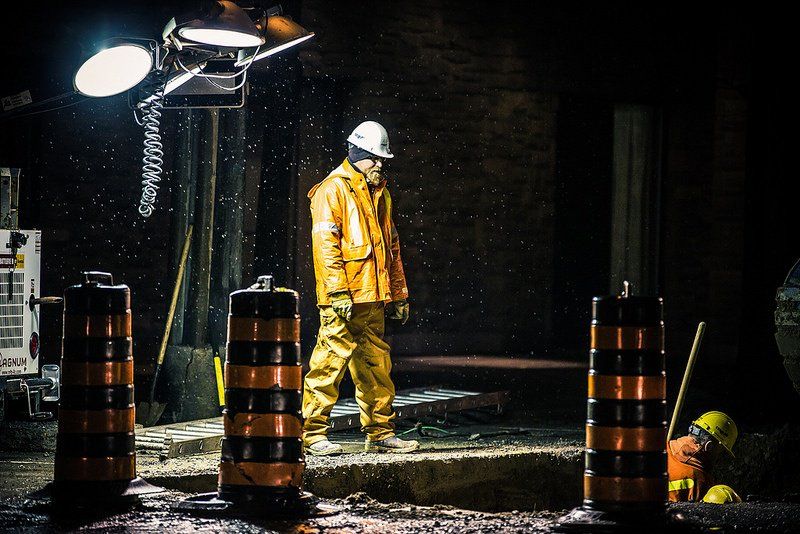Working in the Rain - Regulations You Need to Know About
The British weather is (in)famous for its rain, meaning that those who work outside are at risk of getting wet. Are there any specific ‘working in the rain’ regulations? What are an employers’ responsibilities when employees are working in wet weather? Do you continue to work in the rain?
- What Should You Know?
- PPE Regulations
- Weather Exposure
- Protecting Yourself from the Elements
- Legal Requirements for Workplace Temperature
- Prioritise Safety in Adverse Conditions
What Should You Know About Working in the Rain?
There are no UK regulations to say that workers cannot work in the rain. However, safety measures still need to be in place. Employers need to provide suitable protective clothing for employees that may need to be insulating or heat resistant and slip-resistant safety footwear.
It is important to acclimatise your workers to their environment. Train your workers on any precautions they need to take and supervise the environment to make sure everyone is as safe as possible.
PPE Regulations
The Personal Protective Equipment at Work Regulations of 1992 specifies that employers provide their staff with free protective equipment. The equipment should be fit to use, fit correctly, and be maintained. Employers must also provide training on how to use the equipment.
Updated in 2002, regulations note that equipment must be CE-marked. It is also important to make sure your health and safety policy is up to date.
Weather Exposure
Snow exposure can increase the likelihood of accidents such as slipping and falling. But most do not realise rain and cold can be just as damaging.
Those working in the rain are just as likely to have an injury and the single most common injuries caused in the UK are slipping and tripping.
When driving, stopping distances can double, so it is important that your workers driving vehicles know of conditional changes and adapt.
Exposure to cold and rain can cause cold stress, chilblains and, in more serious cases, hypothermia and frostbite.
Chilblains are itchy red patches on the skin caused by being in the cold. They appear on fingers and toes and can appear on your face and legs when exposed to cold and damp conditions.
Frostbite causes the affected parts to feel cold and painful. It can affect any part of your body.
Hypothermia results when the body temperature drops too low. If this happens, you will be fatigued, shiver, lose coordination, and can become confused. Your skin may turn blue, have dilated pupils, a slow pulse, may become unconscious, slowed breathing, and stop shivering.

Protecting Yourself from the Elements
In rainy conditions, your workers will want waterproof trousers, waterproof coats and waterproof shoes or safety boots. Waterproof clothing, however, is not always windproof, and after hours of exposure, it is not always waterproof either. When you are wet and cold, you are at a greater risk of making mistakes and poor decisions that could result in a safety issue.
If hi vis is required, opt for a waterproof hi vis over-trouser and jacket set and make sure the clothing meets PPE regulations.
Legal Requirements for Workplace Temperature
The law informs us of the minimum workplace temperature but not the maximum. Temperatures indoors have to be “reasonable.”
The minimum temperature is 16° Celsius. If you are working and moving rigorously, such as outdoor work, the minimum temperature should be at least 13° Celsius. However, the grey area is that employers have the duty to determine what is considered reasonable and comfortable.
A thorough risk assessment should be done in all conditions including rainy conditions and your employer has a duty to protect you from harm.
Prioritise Safety in Adverse Conditions
Make sure you have site supervisors who are trained in recognising conditions caused by the rain and cold, such as frostbite, chilblains, and hypothermia. Report all incidents and treat immediately.
It is also a good idea to limit exposure and rotate workers so that everyting works properly. For example, since waterproofing does not always last all day, give your workers opportunities for breaks, to change clothes, and get dry and warm before sending them back out in those conditions again.
Rotate your workers to avoid these problems too, or on wet and cold days try to find alternative jobs. Always make sure your staff have the right equipment for conditions.
Conclusion
There are no regulations about working in the rain but there still needs to be safety measures in place. Employees must equip their staff with free equipment and provide training on how to use it.
Your staff are just as likely to have an injury in the rain as they are in the snow. It is important to protect your workers with the right workwear, such as waterproof clothing and safety boots.
Make sure you are adhering to the Health & Safety laws and check the temperature your staff are working in. Most importantly, prioritise the safety of your workers.






